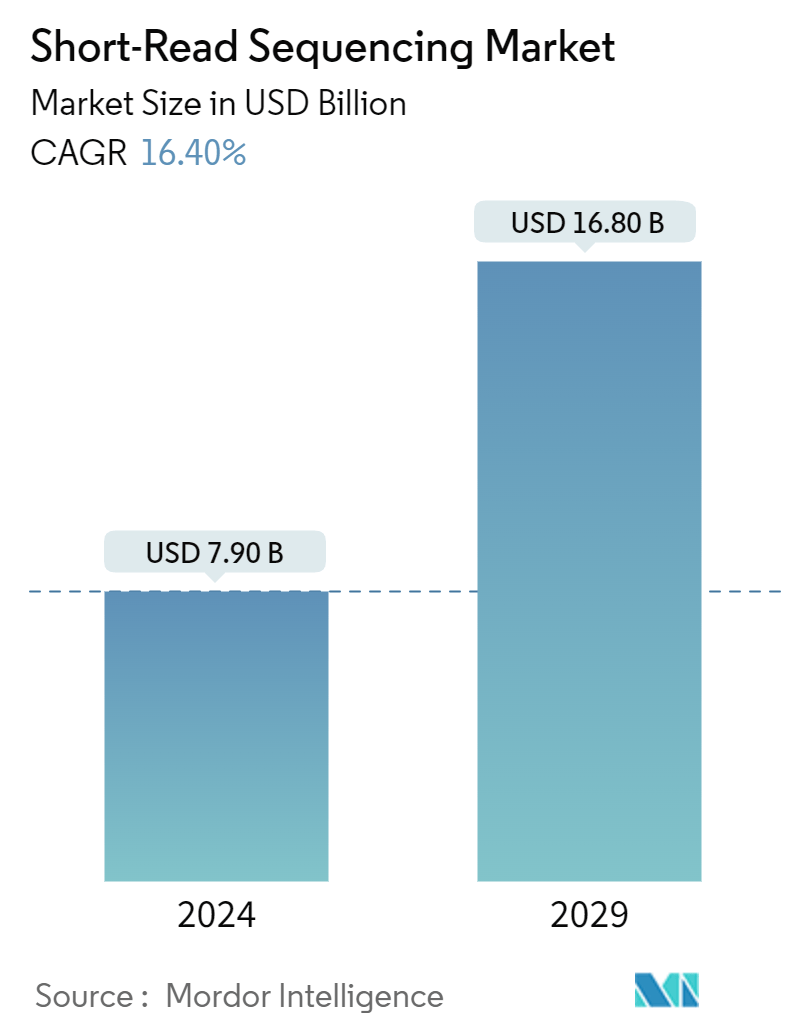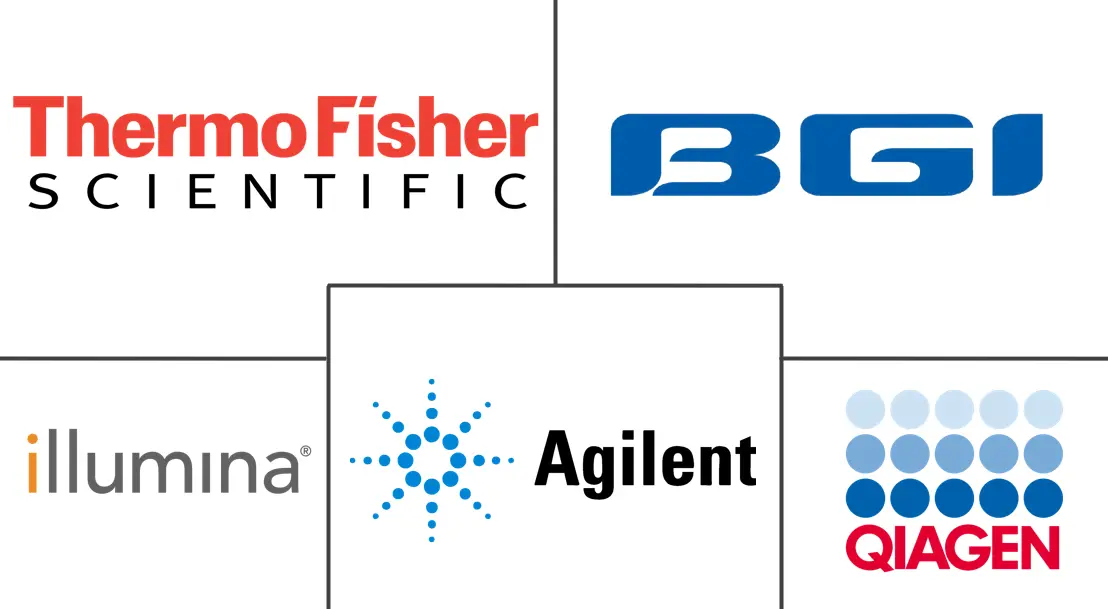Market Size of Short-Read Sequencing Industry

| Study Period | 2019 - 2029 |
| Market Size (2024) | USD 7.90 Billion |
| Market Size (2029) | USD 16.80 Billion |
| CAGR (2024 - 2029) | 16.40 % |
| Fastest Growing Market | Asia Pacific |
| Largest Market | North America |
Major Players
*Disclaimer: Major Players sorted in no particular order |
Short-Read Sequencing Market Analysis
The Short-Read Sequencing Market size is estimated at USD 7.90 billion in 2024, and is expected to reach USD 16.80 billion by 2029, growing at a CAGR of 16.40% during the forecast period (2024-2029).
The short-read sequencing market is influenced by several factors that impact its growth and adoption in the genomics and life sciences sectors. Some of the major driving factors include rising demand for precision medicine, continuous advancements in genomics research, and cost-effectiveness and efficiency of short-read sequencing technologies.
Continuous advancements in genomics research drive the demand for sequencing technologies to study genetic variations, disease mechanisms, and personalized medicine. For instance, in May 2024, SOPHiA GENETICS, a cloud-native healthcare technology company, partnered with Microsoft and NVIDIA. This collaboration aims to harness their combined technological and genomic expertise. The goal is to introduce a more efficient and scalable solution for whole genome sequencing (WGS) analysis in healthcare institutions. Hence, technological advancements in sequencing help analyze data using short-read sequencing methods, which is expected to boost market growth during the forecast period.
Also, growing company activities such as collaborations, partnerships, and agreements for developing new products are expected to propel the market growth during the forecast period. For instance, in August 2023, PacBio, a leading provider of precise sequencing solutions, agreed to acquire Apton Biosystems Inc. (Apton). Apton, headquartered in the United States, specializes in a cutting-edge short-read sequencer. This approach efficiently tests billions of DNA clusters on a single flow cell. Hence, these strategic activities increase the company’s portfolios and are expected to drive market growth during the forecast period.
Therefore, continuous advancements in genomics research and company activities are expected to increase the demand for short-read sequencing products and services, boosting market growth during the forecast period. However, complexity in sequencing data analysis and interpretation and competition from other sequencing technologies are expected to restrain market growth during the forecast period.
Short-Read Sequencing Industry Segmentation
As per the scope of the report, short-read sequencing refers to a genomic sequencing method that generates relatively short DNA or RNA fragments, typically ranging from 50 to 300 base pairs in length. Due to its cost-effectiveness, high accuracy, and scalability, short-read sequencing is widely used in genomics research, clinical diagnostics, and other fields.
The short-read sequencing market is segmented by products and services, platforms, applications, end users, and geography. By products and services, the market is segmented into instruments, consumables, and services. By platform, the market is segmented into sequencing by synthesis (SBS), sequencing by binding (SBB), and sequencing by ligation (SBL). By application, the market is segmented into whole genome sequencing (WGS), whole exome sequencing (WES), and other applications. The market is segmented by end user into academic and research institutes, pharmaceutical and biotechnology companies, clinical research laboratories, and other end users. The market is segmented by geography into North America, Europe, Asia-Pacific, the Middle East and Africa, and South America. The report also covers the estimated market sizes and trends for 17 countries across the major regions globally. The report offers the value (in USD) for the above segments.
| By Product and Services | |
| Instruments | |
| Consumables | |
| Services |
| By Platform | |
| Sequencing by Synthesis (SBS) | |
| Sequencing by Binding (SBB) | |
| Sequencing by Ligation (SBL) |
| By Application | |
| Whole Genome Sequencing (WGS) | |
| Whole Exome Sequencing (WES) | |
| Other Applications |
| By End User | |
| Academic and Research Institutes | |
| Pharmaceutical and Biotechnology Companies | |
| Clinical Research Laboratories | |
| Other End Users |
| Geography | ||||||||
| ||||||||
| ||||||||
| ||||||||
| ||||||||
|
Short-Read Sequencing Market Size Summary
The short-read sequencing market is poised for substantial growth, driven by the increasing demand for precision medicine and advancements in genomics research. The market's expansion is supported by the cost-effectiveness and efficiency of short-read sequencing technologies, which are becoming integral in studying genetic variations and disease mechanisms. Collaborations and strategic partnerships, such as those between SOPHiA GENETICS, Microsoft, and NVIDIA, are enhancing the scalability and efficiency of whole genome sequencing (WGS) analysis. These developments are expected to significantly boost the market's growth trajectory over the forecast period. However, challenges such as the complexity of sequencing data analysis and competition from alternative sequencing technologies may pose constraints to market expansion.
The application of short-read sequencing in whole genome sequencing is particularly noteworthy, as it offers comprehensive insights into an organism's DNA, including both coding and non-coding regions. This segment is expected to experience significant growth due to its high throughput, accuracy, and clinical relevance. The market's growth is further supported by substantial research funding and the establishment of new sequencing services, particularly in North America, where a strong presence of established players and developed healthcare infrastructure exists. The competitive landscape is semi-consolidated, with major players like Illumina Inc., Thermo Fisher Scientific Inc., and QIAGEN leading the market. These companies are continuously enhancing their offerings, as seen in recent developments such as Firalis Molecular Precision's acquisition of the Illumina NovaSeq X Plus Sequencing System and PacBio's commercialization of the Onso short-read sequencing system.
Short-Read Sequencing Market Size - Table of Contents
-
1. MARKET DYNAMICS
-
1.1 Market Overview
-
1.2 Market Drivers
-
1.2.1 Rising Demand for Precision Medicine
-
1.2.2 Continuous Advancements in Genomics Research
-
1.2.3 Cost-Effectiveness and Efficiency of Short-read Sequencing Technologies
-
-
1.3 Market Restraints
-
1.3.1 Complexity in Sequencing Data Analysis and Interpretation
-
1.3.2 Competition from Other Sequencing Technologies
-
-
1.4 Porter's Five Force Analysis
-
1.4.1 Threat of New Entrants
-
1.4.2 Bargaining Power of Buyers/Consumers
-
1.4.3 Bargaining Power of Suppliers
-
1.4.4 Threat of Substitute Products
-
1.4.5 Intensity of Competitive Rivalry
-
-
-
2. MARKET SEGMENTATION (Market Size by Value - USD)
-
2.1 By Product and Services
-
2.1.1 Instruments
-
2.1.2 Consumables
-
2.1.3 Services
-
-
2.2 By Platform
-
2.2.1 Sequencing by Synthesis (SBS)
-
2.2.2 Sequencing by Binding (SBB)
-
2.2.3 Sequencing by Ligation (SBL)
-
-
2.3 By Application
-
2.3.1 Whole Genome Sequencing (WGS)
-
2.3.2 Whole Exome Sequencing (WES)
-
2.3.3 Other Applications
-
-
2.4 By End User
-
2.4.1 Academic and Research Institutes
-
2.4.2 Pharmaceutical and Biotechnology Companies
-
2.4.3 Clinical Research Laboratories
-
2.4.4 Other End Users
-
-
2.5 Geography
-
2.5.1 North America
-
2.5.1.1 United States
-
2.5.1.2 Canada
-
2.5.1.3 Mexico
-
-
2.5.2 Europe
-
2.5.2.1 Germany
-
2.5.2.2 United Kingdom
-
2.5.2.3 France
-
2.5.2.4 Italy
-
2.5.2.5 Spain
-
2.5.2.6 Rest of Europe
-
-
2.5.3 Asia-Pacific
-
2.5.3.1 China
-
2.5.3.2 Japan
-
2.5.3.3 India
-
2.5.3.4 Australia
-
2.5.3.5 South Korea
-
2.5.3.6 Rest of Asia-Pacific
-
-
2.5.4 Middle East and Africa
-
2.5.4.1 GCC
-
2.5.4.2 South Africa
-
2.5.4.3 Rest of Middle East and Africa
-
-
2.5.5 South America
-
2.5.5.1 Brazil
-
2.5.5.2 Argentina
-
2.5.5.3 Rest of South America
-
-
-
Short-Read Sequencing Market Size FAQs
How big is the Short-Read Sequencing Market?
The Short-Read Sequencing Market size is expected to reach USD 7.90 billion in 2024 and grow at a CAGR of 16.40% to reach USD 16.80 billion by 2029.
What is the current Short-Read Sequencing Market size?
In 2024, the Short-Read Sequencing Market size is expected to reach USD 7.90 billion.

